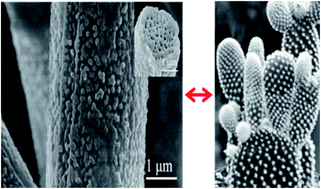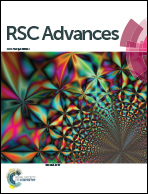Fabrication of a polyvinylidene fluoride cactus-like nanofiber through one-step electrospinning†
Abstract
Surface modification of fibers has attracted significant attention in different areas and applications. In this work, polyvinylidene fluoride (PVDF) cactus-like nanofibers were directly produced via electrospinning at a high relative humidity (RH) of 62%. The formation mechanism of the cactus structure was demonstrated. The effects of the RH on the fabrication of the cactus structure, crystalline phases, mechanical properties, hydrophobicity, and piezoelectric properties of the PVDF nanofibers were investigated. The results showed that the cactus-like nanofibers have a high crystallinity (ΔXc), and an outstanding water contact angle (WCA), as well as good electrical outputs. We believe that the PVDF cactus structure can be used in many applications such as energy harvesting and self-cleaning surfaces.



 Please wait while we load your content...
Please wait while we load your content...